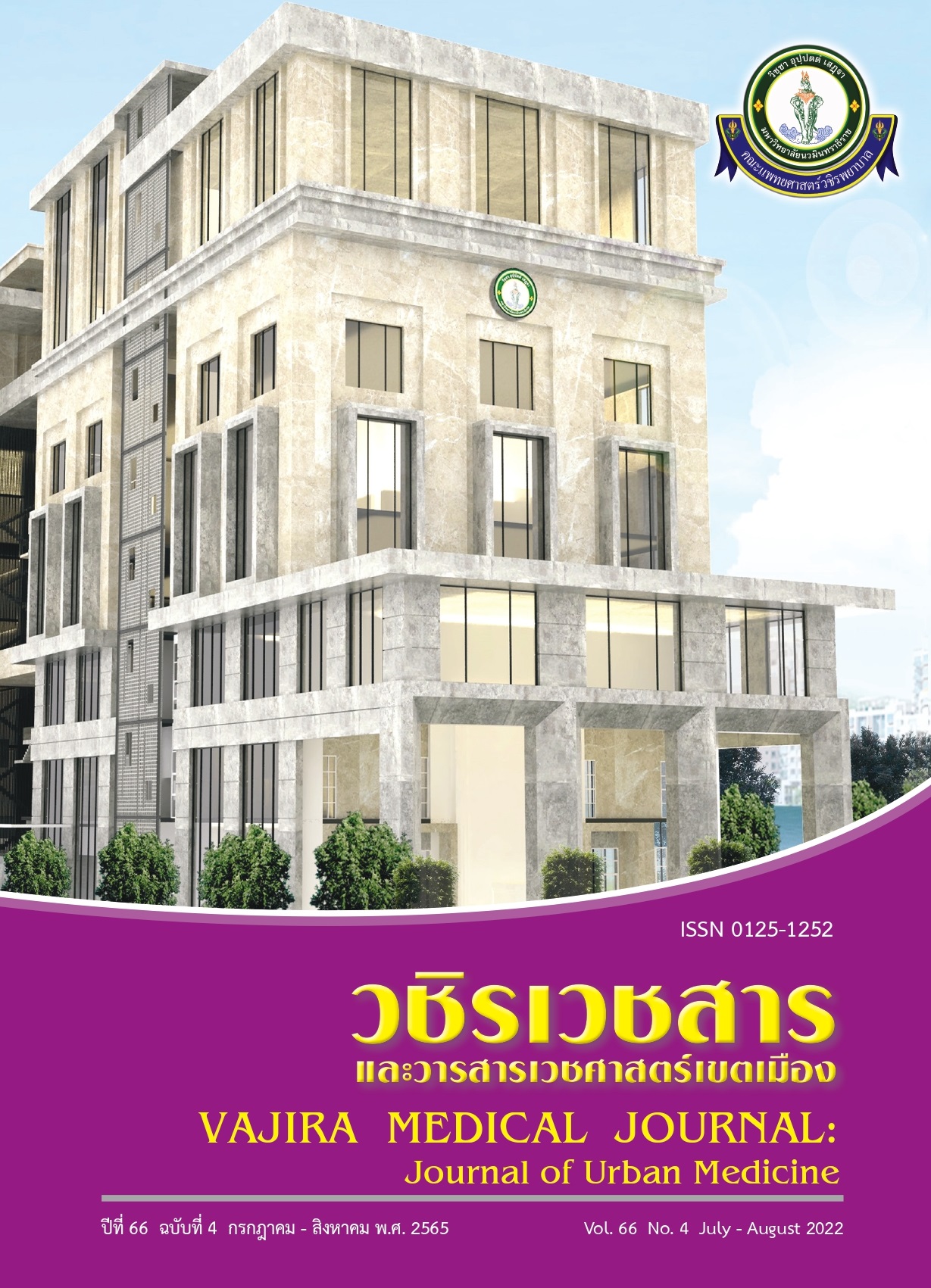Parent-Adolescent Relationship Patterns of Junior High School in Ubonratchathani Province and Its Association with Family Factors
Main Article Content
Abstract
Objective: To study parent-adolescent relationship patterns of junior high school students in Ubonratchathani Province and its association with family factors.
Methods: A cross-sectional descriptive study was conducted on students in a public junior high school in Ubon Ratchathani Province in 2018. Self-reported questionnaires consisted of demographic data of students and their parents, questionnaire about intrafamilial relationships and the Chulalongkorn Family Inventory. Descriptive statistics were presented as frequency, percent and mean. The chi-square test and logistic regression analysis were used to find the associated factors of a parent-child relationship.
Results: There were 733 junior high school student participants; 63.4% were female. Eighty-eight percent reported a closed relationship with their mother, while 66.4% reported a closed relationship with their father. Fifty-two percent of students choose to consult with their parents, and 35.7% choose to consult with friends. The majority (82.8%) of parental marital status were married. Associated factors of closed relationships were 3 domains of family functions: problem-solving, communication and affective responsiveness, parental relationship, and parental marital status.
Conclusion: Most junior high school students had a closed relationship with their mother and father. The associated factors of this closed relationship were family function on problem-solving, communication and affective responsiveness, parents’ marital relationship and parental marital status.
Downloads
Article Details

This work is licensed under a Creative Commons Attribution-NonCommercial-NoDerivatives 4.0 International License.
References
Trangkasombat U. Family therapy and family counseling. 5th ed. Bangkok: Family Research and Development Center;2001.
Ranson KE, Urichuk LJ. The effect of parent–child attachment relationships on child biopsychosocial outcomes: a review. Early Child Dev Care 2008;178(2):129–52.
Laursen B, Collins WA. Parent-child relationships during adolescence. In: Lerner RM, Steinberg L, editors. Handbook of adolescent psychology: contextual influences on adolescent development. 3rd ed. Hoboken: John Wiley & Sons; 2009. p. 3-42.
Branje SJT, Laursen B, Collins WA. Parent–child communication during adolescence. In: Vangelisti AL, editor. Routledge handbook of family communication. New York: Routledge; 2012. p. 271–86.
Larson RW, Richards MH, Moneta G, Holmbeck G, Duckett E. Changes in adolescents' daily interactions with their families from ages 10 to 18: Disengagement and transformation. Dev Psychol 1996;32(4):744-54.
Steinberg L. We know some things: parentadolescent relationships in retrospect and prospect. J Res Adolesc 2001; 11(1): 1–19.
Steinberg L, Silk JS. Parenting adolescents. In Bornstein MH, editor. Handbook of parenting: children and parenting. 2nd ed. Mahwah : Lawrence Erlbaum Associates Publishers; 2002. p. 103-33.
Flouri E, Buchanan A. What predicts good relationships with parents in adolescence and partners in adult life: findings from the 1958 British birth cohort. J Fam Psychol 2002;16(2):186-98.
Alaie I, Låftman SB, Jonsson U, Bohman H. Parent-youth conflict as a predictor of depression in adulthood: a 15-year follow-up of a community-based cohort. Eur Child Adolesc Psychiatry 2020;29(4):527-36.
Gonzales NA, Knight GP, Gunn HJ, Tein JY, Tanaka R, White RMB. Intergenerational gaps in Mexican American values trajectories: associations with parent-adolescent conflict and adolescent psychopathology. Dev Psychopathol 2018;30(5):1611-27.
Visser L, de Winter AF, Reijneveld SA. The parent-child relationship and adolescent alcohol use: a systematic review of longitudinal studies. BMC Public Health 2012; 12:886.
Allen JP, Porter M, McFarland C, McElhaney KB, Marsh P. The relation of attachment security to adolescents' paternal and peer relationships, depression, and externalizing behavior. Child Dev 2007; 78(4):1222–39.
Sheeber LB, Davis B, Leve C, Hops H, Tildesley E. Adolescents' relationships with their mothers and fathers: associations with depressive disorder and subdiagnostic symptomatology. J Abnorm Psychol 2007; 116(1):144–54.
Grandi S, Scortichini S, Fabbri S. The McMaster model of family functioning. Rivista di Psichiatria 2007;42(2):99-107.
Shek DTL, Dou D. Perceived parenting and parent-child relational qualities in fathers and mothers: longitudinal findings based on Hong Kong adolescents. Int J Environ Res Public Health 2020;17(11):4083.
Yan J, Schoppe-Sullivan SJ, Feng X. Trajectories of mother-child and father-child relationships across middle childhood and associations with depressive symptoms. Dev Psychopathol 2019;31(4):1381-93.
Palkovitz R, Trask BS, Adamsons K. Essential differences in the meaning and processes of mothering and fathering: family systems, feminist and qualitative perspectives. J Fam Theory Rev 2014; 6:406–20.
Song H, Thompson RA, Ferrer E. Attachment and self-evaluation in Chinese adolescents: age and gender differences. J Adolesc 2009;32(5):1267-86.
Almeida DM, Galambos NL. Examining father involvement and the quality of father-adolescent relations. J Res Adolesc 1991;1(2):155–72.
Wierson M, Armistead L, Forehand R, Thomas AM, Fauber R. Parent-adolescent conflict and stress as a parent: Are there differences between being a mother or a father?. J Fam Violence 1990; 5(3):187–97.
Forehand R, Nousiainen S. Maternal and paternal parenting: Critical dimensions in adolescent functioning. J Fam Psychol 1993;7(2): 213–21.
Keijsers L, Poulin F. Developmental changes in parent-child communication throughout adolescence. Dev Psychol 2013;49(12):2301–8.
Hamza CA, Willoughby T. Perceived parental monitoring, adolescent disclosure, and adolescent depressive symptoms: a longitudinal examination. J Youth Adolesc 2011;40(7):902-15.
Kouros CD, Papp LM, Goeke-Morey MC, Cummings EM. Spillover between marital quality and parent-child relationship quality: parental depressive symptoms as moderators. J Fam Psychol 2014 ;28(3):315-25.
O'Connor TG, Dunn J, Jenkins JM, Rasbash J. Predictors of between-family and within-family variation in parent-child relationships. J Child Psychol Psychiatry 2006;47(5):498-510.
Wilkinson R. Age and sex differences in the influence of attachment relationships on adolescent psychological health. Aust J Educ Dev Psychol 2006;23(2):87-104.
Tiyapan N. Relationship between parenting styles and academic achievement in Mathayom 6 school students. Rama Med J 2011;34(4):207-14
Shek DT, Xie Q, Lin L. The impact of family intactness on family functioning, parental control, and parent-child relational qualities in a chinese context. Front. Pediatr 2014;2:149.
Kakihara F, Tilton-Weaver L, Kerr M, Stattin H. The relationship of parental control to youth adjustment: do youths' feelings about their parents play a role? J Youth Adolesc 2010;39(12):1442-56.


